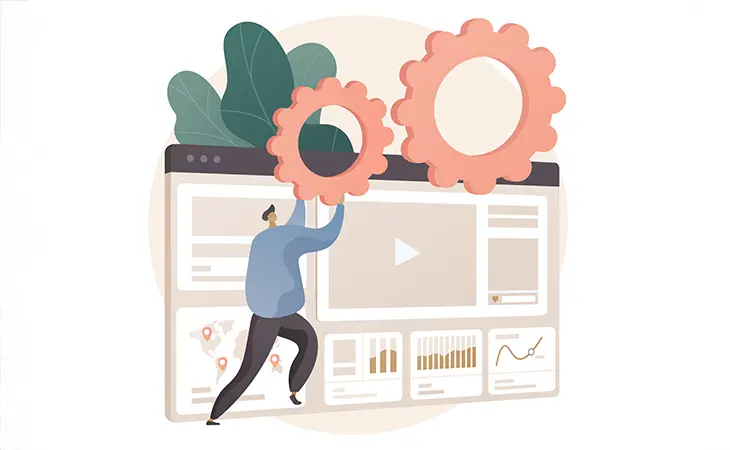Faster, But Intact: How to Improve Website Speed Without Breaking Everything
We’ve all been there, in an attempt to make our site faster and we end up with half the images missing, broken sliders, or an entire checkout page gone. If you’re running a business site, that’s the worst possible trade-off. So let’s walk through how to improve website speed without nuking your user experience or killing your conversions.
Why speed matters:
Attention is short. On mobile, a delay between tap and response feels like “this site is broken.” You don’t get the benefit of the doubt twice.
It changes behavior. Slow LCP and janky layouts kill intent: fewer scrolls, fewer taps, fewer form starts. Conversion drops aren’t mysterious when the interface is lagging.
Google measures it. Core Web Vitals are real levers: LCP (how fast the main content paints), INP (overall input responsiveness), CLS (layout stability). Miss these and organic visibility gets harder.
Cost compounds. Slow sites waste paid ad spend, spike bounce on landing pages, and increase server load. You pay three times: in traffic, in revenue, and in infrastructure.
Trust signal. A site that feels instant reads as competent and safe. That translates to higher completion rates on anything that asks for money or data.
So yes, speed is a business problem first, a technical problem second. Now let’s talk about how to improve website speed safely.
Stage 0 – Guardrails: don’t “optimize” your way into a broken site
Clone to staging and test there first.
Baseline with PageSpeed Insights, WebPageTest, and a quick Chrome Performance trace. Save screenshots.
Set a rollback: full backup + git or host-level restore point.
Monitor: add real‑user Web Vitals (e.g., use the web-vitals library to send LCP/INP/CLS to GA4 or Logtail). If production dips, you’ll know within minutes.
Stage 1 – Images: the biggest, safest win
Goal: Fast LCP without visual regressions.
Convert hero and product images to WebP/AVIF; keep PNG for transparency-heavy UI sprites.
Serve properly sized variants with
srcsetandsizes.Preload the hero image to accelerate LCP.
Lazy‑load everything below the fold.
HTML example (hero image + preload):
<link rel="preload" as="image" href="/img/hero@2x.webp" imagesrcset="/img/hero.webp 1x, /img/hero@2x.webp 2x" imagesizes="(min-width: 768px) 100vw, 100vw">
<img fetchpriority="high" decoding="async" src="data:image/svg+xml,%3Csvg%20xmlns='http://www.w3.org/2000/svg'%20viewBox='0%200%201600%20900'%3E%3C/svg%3E" data-lazy-srcset="/img/hero.webp 1x, /img/hero@2x.webp 2x" data-lazy-sizes="100vw" width="1600" height="900" alt="Your product in action" fetchpriority="high" title="How to Improve Website Speed Without Breaking Everything 1" data-lazy-src="/img/hero.webp"><noscript><img fetchpriority="high" decoding="async" src="/img/hero.webp" srcset="/img/hero.webp 1x, /img/hero@2x.webp 2x" sizes="100vw" width="1600" height="900" alt="Your product in action" fetchpriority="high" title="How to Improve Website Speed Without Breaking Everything 1"></noscript>
WordPress helper (functions.php – enqueue lazy loading off for hero only):
add_filter('wp_lazy_loading_enabled', function($default, $tag, $context){
if ($tag === 'img' && isset($context['attributes']['class']) && strpos($context['attributes']['class'], 'hero-image') !== false) {
return false; // hero loads eagerly, others lazy by default
}
return $default;
}, 10, 3);
Stage 2 – Fonts: beauty without the blocking
Self‑host WOFF2.
Use
font-display: swap;to avoid invisible text.Preload only the one primary text face you actually render above the fold.
css:
@font-face{
font-family:"Inter";
src:url("/fonts/inter.woff2") format("woff2");
font-weight:400 700;
font-display:swap;
}
html:
<link rel="preload" as="font" type="font/woff2" href="/fonts/inter.woff2" crossorigin>
Stage 3 – JavaScript: cut, then schedule
JS is the #1 INP killer. Reduce, then defer.
Remove what you don’t need (sliders on pages without sliders, analytics you never use).
Defer non‑critical scripts; async third‑party where safe.
Delay hydration for below‑the‑fold components.
WordPress (functions.php – defer specific scripts):
add_filter('script_loader_tag', function($tag, $handle){
$defer = ['contact-form-7','some-slider','marketing-suite'];
if (in_array($handle, $defer)) {
$tag = str_replace(' src', ' defer src', $tag);
}
return $tag;
}, 10, 2);
js:
// Delay heavy widget until idle
requestIdleCallback(() => import('/js/review-widget.js'));
Stage 4 – CSS: deliver critical fast, stream the rest
Inline critical CSS for the above‑the‑fold shell (header, hero, nav).
Load the full stylesheet with
media="print"swap or simply a normal preload→load sequence.Purge unused CSS (safelist dynamic classes from builders).
HTML (critical + non‑critical):
<style>/* critical: header, nav, hero, above-the-fold layout */</style>
<link rel="preload" as="style" href="/css/app.min.css">
<link rel="stylesheet" href="/css/app.min.css">
Stage 5 – Network & server: reduce wait, reduce hops
HTTP/2 or HTTP/3 enabled at the edge.
CDN for static assets; set long cache lifetimes with versioned filenames.
Preconnect to third parties you truly need (one or two, not ten).
Keep TTFB low with PHP‑FPM tuning, object cache (Redis), and a modern PHP version.
.htaccess (browser caching):
<IfModule mod_expires.c>
ExpiresActive On
ExpiresByType image/webp "access plus 1 year"
ExpiresByType font/woff2 "access plus 1 year"
ExpiresByType text/css "access plus 1 month"
ExpiresByType application/javascript "access plus 1 month"
</IfModule>
HTML (preconnect – use sparingly):
<link rel="preconnect" href="https://www.google-analytics.com" crossorigin>
Stage 6 – Caching that doesn’t cause ghosts
Full‑page cache for anonymous users.
Object cache (Redis) to speed DB calls.
Don’t cache pages with personalized states (carts, dashboards) without careful rules.
Always test logins, forms, carts, and search after any cache change.
Stage 7 – Measure again, then fix the right thing
Rerun PageSpeed Insights and WebPageTest. Validate in the Performance tab:
LCP target: ≤ 2.5s on 4G mobile.
INP target: ≤ 200ms for primary interactions.
CLS target: ≤ 0.10.
If LCP is still slow, look at hero image weight and render path. If INP is poor, audit long tasks in the main thread (DevTools → Performance → Bottom‑up; kill the worst offenders). If CLS spikes, stabilize dimensions and avoid late font swaps.
Stage 8 – Safe rollout checklist
Staging passes Core Web Vitals on mobile.
Forms, search, cart, modals: tested.
Analytics events still fire (GA4 events, Ads tags).
Roll to production during low‑traffic window.
Watch RUM metrics and error logs for 24–48 hours.
Final Thoughts
Learning how to improve website speed is learning how browsers actually build a page: bytes → parse → paint → respond. When you respect that pipeline, your site feels instant without hacks or heroics. Do the boring fundamentals well—images, JS, CSS, caching, server—and you’ll ship a site that loads fast, stays stable, and converts better. That’s the work.
Further Reading
Want to learn more about how to improve website speed and keep your site running smoothly? These resources dive deeper into advanced techniques and real-world case studies.
- WP Rocket – How to Improve Your Google PageSpeed Score
- Kinsta – How to Speed Up Your WordPress Site
- Smashing Magazine – Optimizing Core Web Vitals
Ready to Fix Your Website for Good?
Let's Grow Your Business Online
From websites to automation, we’ve helped 100+ business owners grow online




